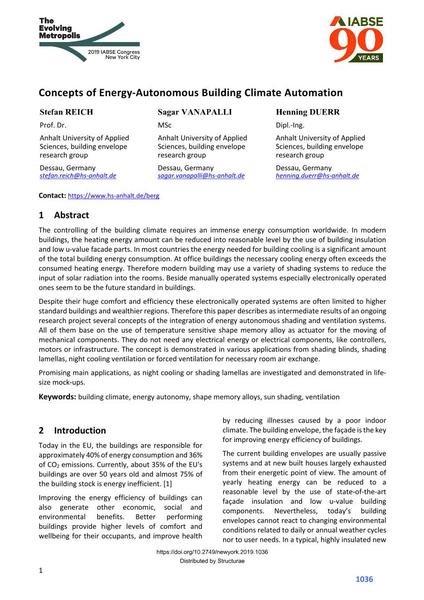Concepts of Energy-Autonomous Building Climate Automation

|
|
|||||||||||
Bibliografische Angaben
| Autor(en): |
Stefan Reich
(Anhalt University of Applied Sciences, building envelope research group)
Sagar Vanapalli (Anhalt University of Applied Sciences, building envelope research group) Henning Duerr (Anhalt University of Applied Sciences, building envelope research group) |
||||
|---|---|---|---|---|---|
| Medium: | Tagungsbeitrag | ||||
| Sprache(n): | Englisch | ||||
| Tagung: | IABSE Congress: The Evolving Metropolis, New York, NY, USA, 4-6 September 2019 | ||||
| Veröffentlicht in: | The Evolving Metropolis | ||||
|
|||||
| Seite(n): | 1036-1042 | ||||
| Anzahl der Seiten (im PDF): | 7 | ||||
| DOI: | 10.2749/newyork.2019.1036 | ||||
| Abstrakt: |
The controlling of the building climate requires an immense energy consumption worldwide. In modern buildings, the heating energy amount can be reduced into reasonable level by the use of building insulation and low u-value facade parts. In most countries the energy needed for building cooling is a significant amount of the total building energy consumption. At office buildings the necessary cooling energy often exceeds the consumed heating energy. Therefore modern building may use a variety of shading systems to reduce the input of solar radiation into the rooms. Beside manually operated systems especially electronically operated ones seem to be the future standard in buildings. Despite their huge comfort and efficiency these electronically operated systems are often limited to higher standard buildings and wealthier regions. Therefore this paper describes as intermediate results of an ongoing research project several concepts of the integration of energy autonomous shading and ventilation systems. All of them base on the use of temperature sensitive shape memory alloy as actuator for the moving of mechanical components. They do not need any electrical energy or electrical components, like controllers, motors or infrastructure. The concept is demonstrated in various applications from shading blinds, shading lamellas, night cooling ventilation or forced ventilation for necessary room air exchange. Promising main applications, as night cooling or shading lamellas are investigated and demonstrated in life- size mock-ups. |
||||
| Stichwörter: |
Lüftung
|
||||
